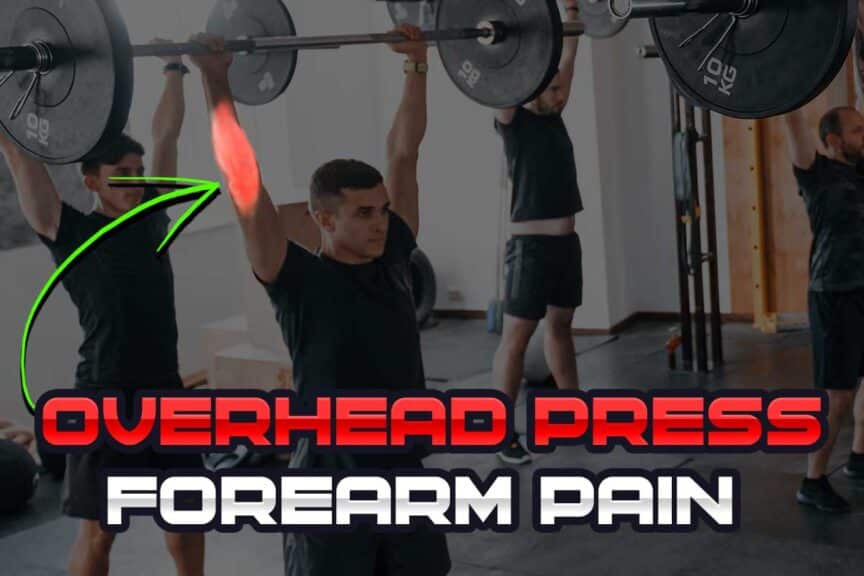Forearm pain with overhead pressing: it may be an odd feeling, but it’s certainly not one that’s uncommon. And thankfully, the reasons as to why this odd — but definitely annoying — phenomenon occurs are often relatively straightforward to clean up. After all, no one likes having unnecessary pain or discomfort when trying to become stronger or healthier overall.
Forearm pain with overhead presses can result from overworked forearm musculature, referred pain from shoulder muscles or even nerve tension within the neck or upper extremity. Solutions involve improving neck and shoulder health and treating muscles of the forearm.
Keep on reading if you want the full breakdown (which will undoubtedly give you some critical insight into getting this issue under control). I will be breaking things down in a straightforward manner while providing some highly effective solutions.
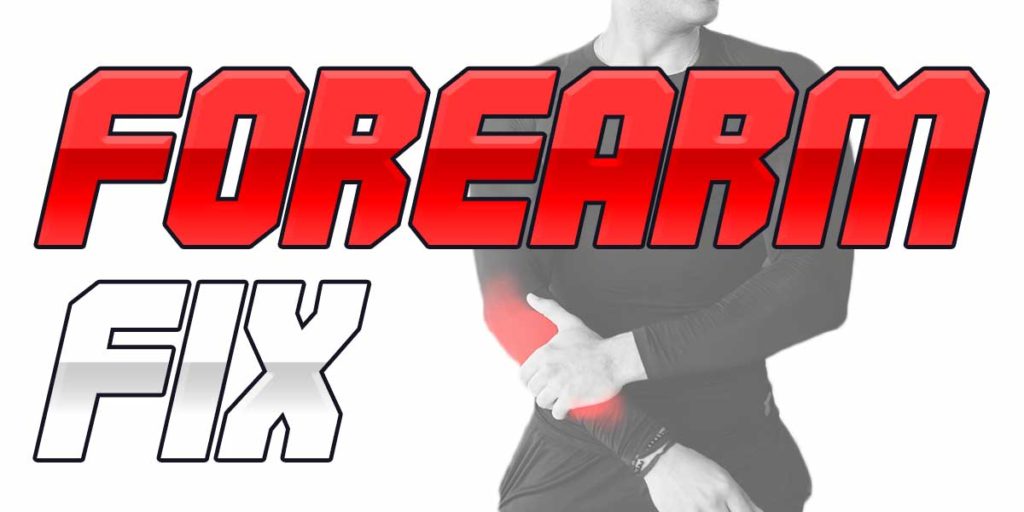
ARTICLE OVERVIEW (Quick Links)
Click/tap any of the following headlines to instantly read that section!
• Overworked forearm muscles
• Unhealthy tendons
• Understanding referred pain
• Potential nerve irritation
• Solution 1: The Forearm muscles
• Solution 2: Treating referred pain
• Solution 3: Neuromobilizations
Related article: How Elbow Sleeves Can Help Your Tendonitis (And Which Ones To Wear)
Disclaimer: While I am a physical therapist, I am not YOUR physical therapist. As a result, I cannot tell you whether or not any treatments or training methodologies mentioned on this website or in this article may or may not be appropriate for you, including treatment for forearm pain. By following any information within this post, you are doing so at your own risk. You are advised to seek appropriate medical advice for any pain you may be experiencing.
Overworked forearm muscles
Common things are common. As a result, while numerous potential factors could be driving or contributing to your forearm pain, it’s best to start with the forearm itself since these muscles are often overworked on active populations, especially lifters and athletes. Let me explain why:
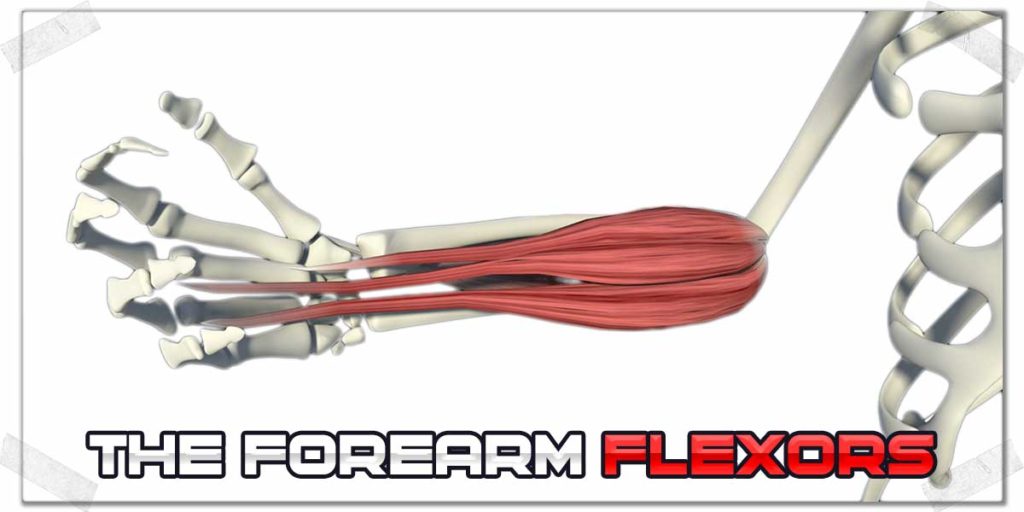
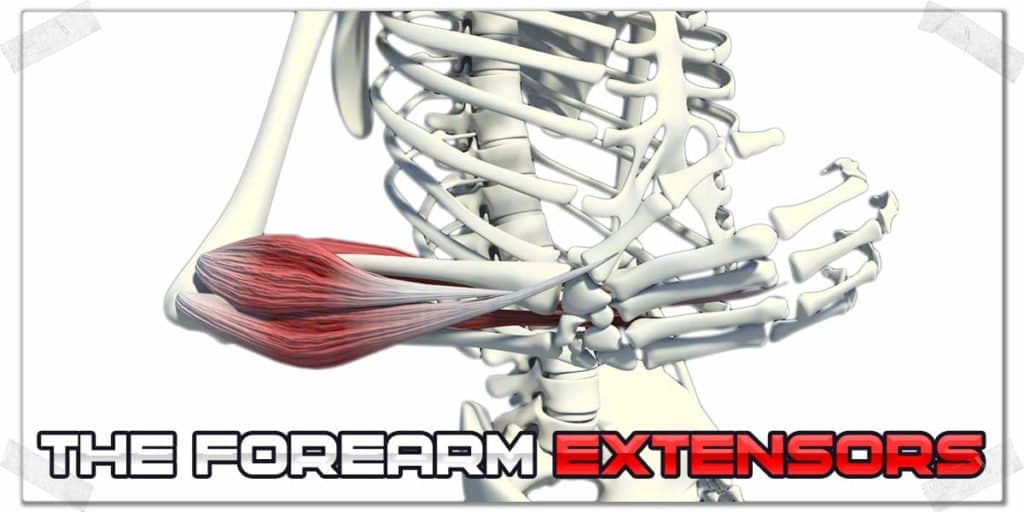
Every time you grab (and hold onto) any fitness equipment (a barbell, dumbbell, etc.,) the forearm flexor muscles are tightened. However, the forearm extensors (on the backside of the forearm) aren’t. Still, to be clear, plenty of exercises will still extensively challenge these extensor muscles — mainly exercises that are performed while having your palms facing away from you (reverse curls, pull-ups, etc.)
When muscles are repeatedly used with demanding exercises, the muscles can become chronically tight, immobile, and otherwise unhealthy. Any or all of these issues can result in pain or discomfort felt within the forearm.
Next thing you know, you’re grabbing and squeezing a barbell or dumbbell and experiencing forearm pain as you press the weight over your head.
Unhealthy tendons
Tendons are the thick, gristly tissues that anchor a muscle down onto a bone. Unlike muscle fibers, a tendon fiber doesn’t contract or shorten. Instead, its job is to transmit the force produced from the muscle to the bone, which produces physical movement of our joints.
Unlike the muscles, tendons have an abysmal blood supply, meaning they don’t receive nearly as much oxygen, nutrients, and other substances required to contribute to their overall health. As a result, tendons receiving high volumes of repeated stress can become unhealthy, resulting in a condition known as tendinopathy.
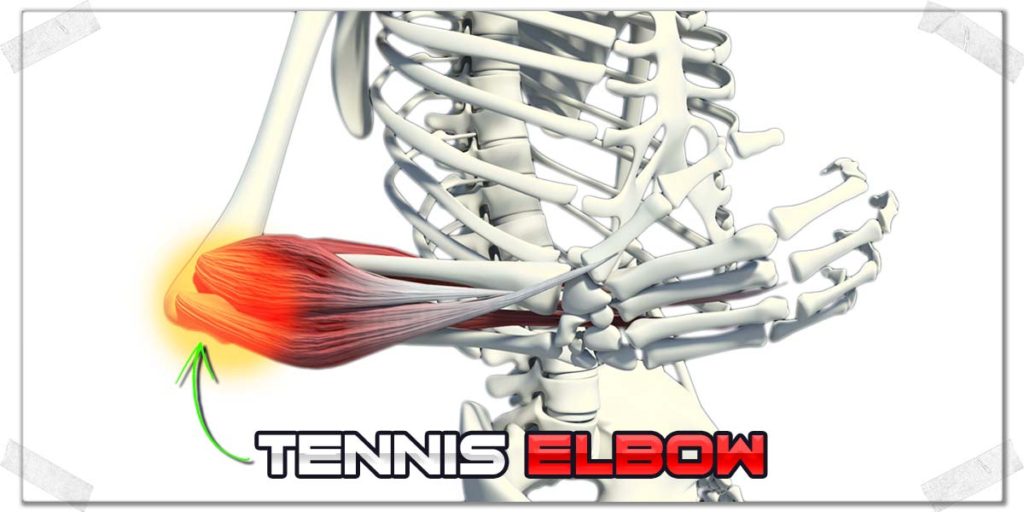
Whenever you are grabbing and squeezing an object (such as a barbell, dumbbell, etc.), you require the forearm muscles to contract, which places mechanical stress on their respective tendons.
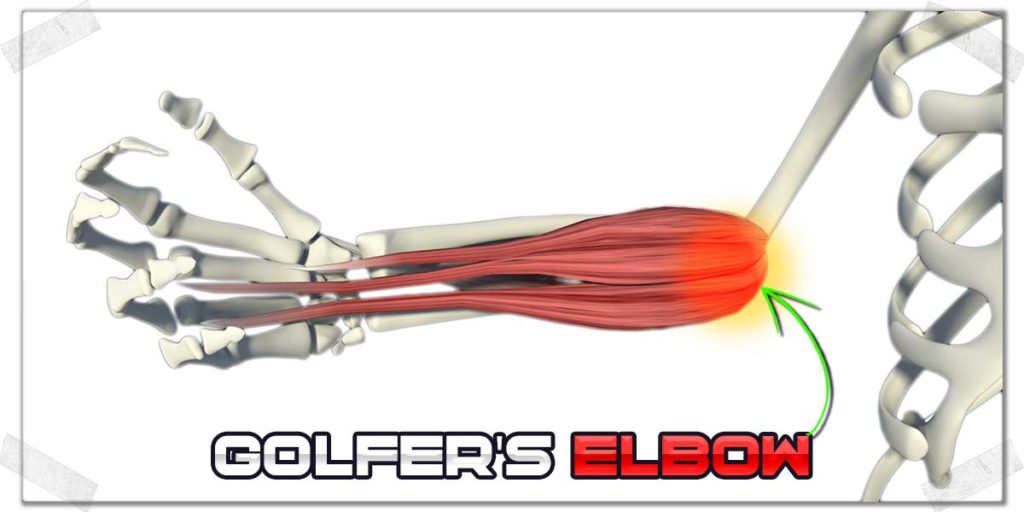
Repetitive activities that place higher volumes of stress on these muscles and tendons can result in irritation or reduced health of the flexor tendons or extensor tendons. These tendons are located on the inside and outside portions of the forearm, respectively. These two areas of the forearm are highly susceptible to becoming sore, unhealthy and painful.
Related article: Tennis Elbow: How To Tape Your Elbow All By Yourself
The result can be pain or discomfort that is typically described as a dull, aching sensation over or around the elbow joint or upper portion of the forearm.
The two most common tendon-based forearm conditions are tennis elbow and golfer’s elbow. They are essentially the exact same condition, just on different sides of the elbow.
Tennis elbow is the result of unhealthy forearm extensor tendons, which are located on the outside portion of the forearm. In contrast, golfer’s elbow is the result of unhealthy forearm flexor tendons, which are located on the inside portion of the forearm.
Pro tip: The term “epicondylitis” (epicondyle = elbow, itis = inflammation) has largely fallen out of favor these days since strong evidence shows that inflammation is not typically present with golfer’s elbow or tennis elbow. The term “epicondylalgia” is now recommended “algia = pain) as a result. So regardless of which term you hear, they very often imply the same condition.
Click on either of the two links below to read the specifics of either of these annoying conditions:
Lateral Epicondylalgia (Tennis elbow)
Medial Epicondylalgia (Golfer’s elbow)
Understanding referred pain
If you were to come to me in the clinic with the problem of forearm pain during overhead presses, the second area on your body I’d perhaps look at and evaluate would be your shoulder. It may sound odd to look at your shoulder when it’s your forearm that’s hurting, but it makes perfect sense once you understand the concept of muscle referral patterns.
When the skeletal muscles within our body are dysfunctional, they can send their pain elsewhere to be felt in the body, which is known as referred pain. When it comes to referred pain, dysfunctional muscles have tell-tale referral patterns for where they send their pain.
The specific and unique referral patterns of skeletal muscles are widely documented and validated, largely off of the work by Travell and Simons, for which their work has become universally adopted in the world of healthcare. Referred pain tends to be perceived as dull, aching and somewhat diffuse, based on the underlying muscle that’s affected. While some muscles tend not to refer pain to other areas of the body, in this particular case, there are two muscles of the shoulder that can refer pain into the forearm.
The two most prominent muscles outside of the forearm likely to be influencing your forearm pain are the supraspinatus and infraspinatus muscles of your shoulder. These two muscles make up two of the four muscles forming the rotator cuff complex.
Take a look at the two referral patterns below. If you suspect that your shoulder pain is coming from the shoulder, read the section of this article later on that discusses dealing with how to treat the underlying issue.
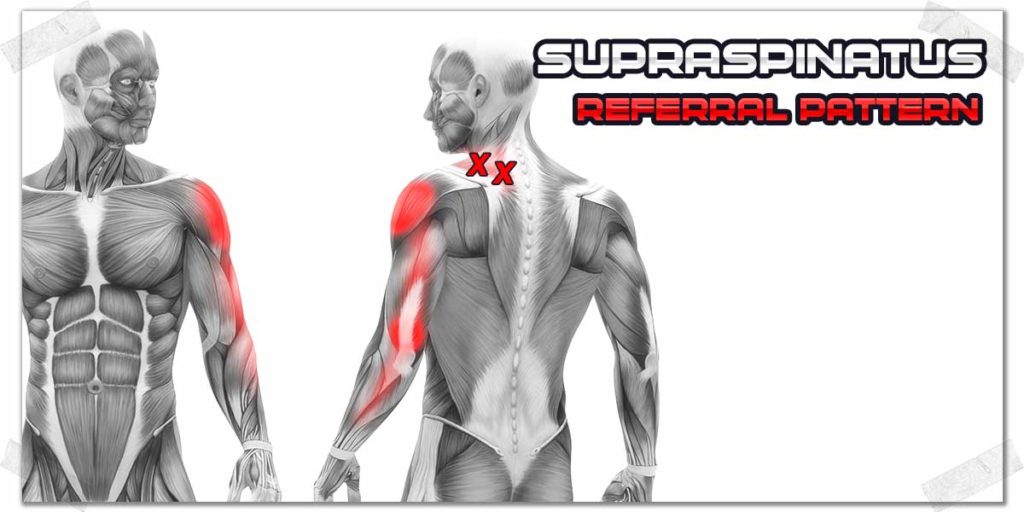
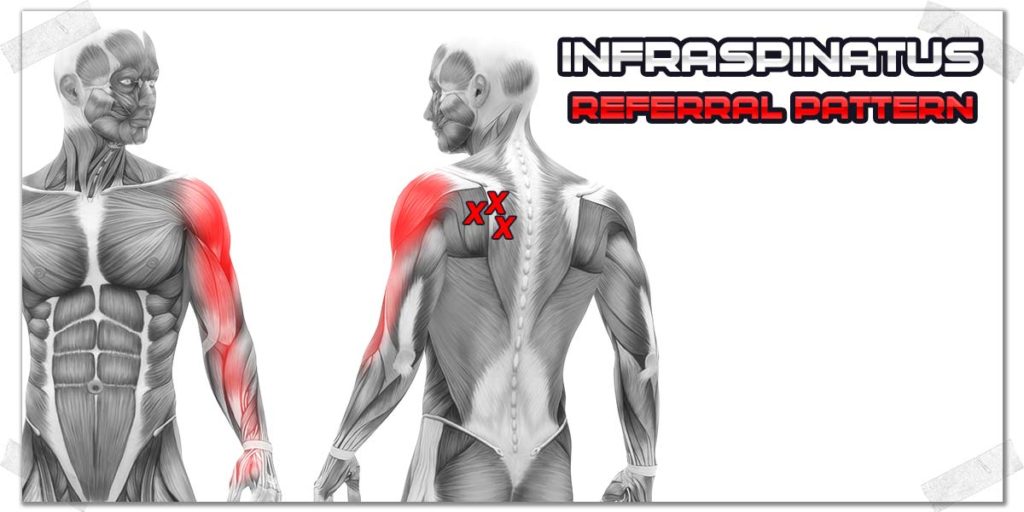
While the deltoid, upper trapezius fibers, and the triceps are some of the more prominent muscles involved with producing the overhead pressing pattern, it’s imperative to realize that the rotator cuff muscles (i.e. the supraspinatus and infraspinatus) must remain active, and thus, work, throughout the entire movement. These muscles help to stabilize and fine-tune our shoulder positioning, so don’t mistake thinking that they’re not working when performing the overhead press.
Not only are these delicate muscles commonly unhealthy on most middle-aged individuals, but they can also often be dysfunctional (tight, restricted) or otherwise unhealthy on active individuals who perform high volumes of upper body training or physical activities.
If you don’t have an understanding of what referred pain is (or that it even exists), it can become quite easy to get caught in the trap of “chasing pain” by erroneously treating symptoms rather than the underlying cause(s).
Related article: Strengthening Your Infraspinatus With A Dumbbell (3 Proven Exercises)
Potential nerve irritation
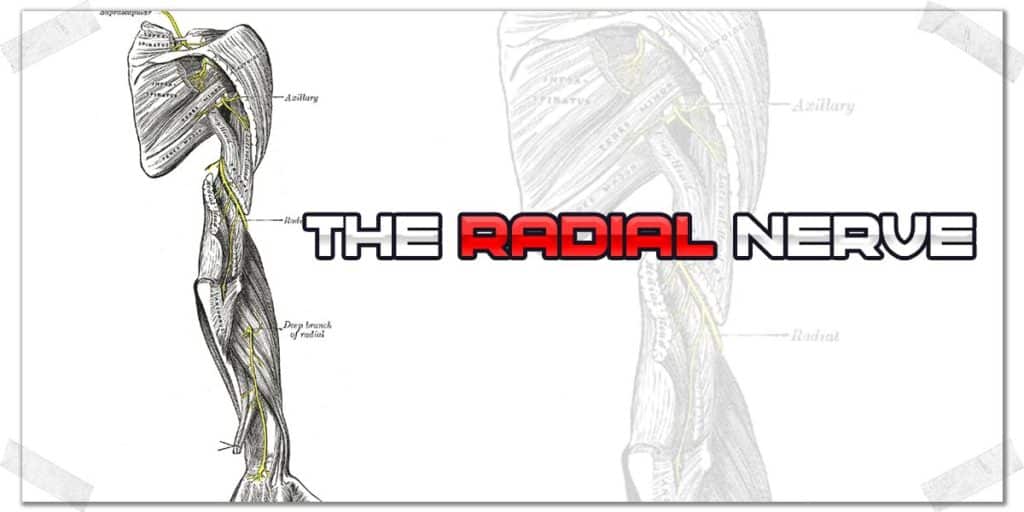
If your forearm muscles themselves, their respective tendons, or the rotator cuff muscles aren’t involved with your pain or discomfort, the next area worth checking out is likely your neck.
If any of the three nerves (that come out of your neck and run down into your arm) are tight or irritated, overhead pressing movement can produce discomfort or pain in your forearm.
There are three primary nerves that travel from your neck, across your forearm and down into your hand:
Most often, I find the radial nerve to cause many of my patient’s forearm discomfort, especially for those who are active and have otherwise healthy muscles and tendons for their forearm and shoulder. Still, there are plenty of times where the nerve pain is arising from the median nerve or the ulnar nerve.
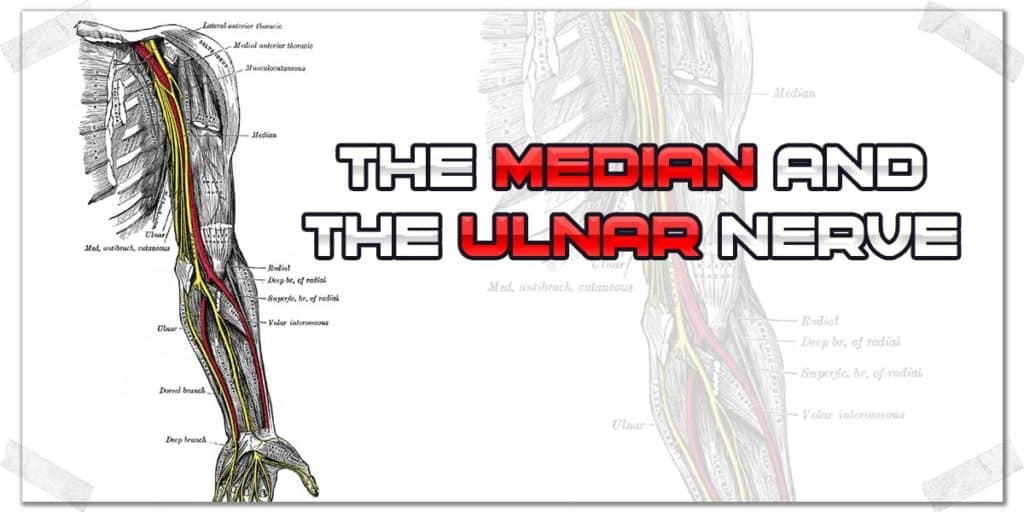
Nerves that are tight, immobile or otherwise unhealthy tend to produce more sharp, well-defined, and traceable pain along a path (known as radicular pain or radiculopathy).
If this is how you’d choose to describe your pain, it very well might be that you’re experiencing the symptoms of an irritated nerve.
Solution 1: The Forearm muscles
If your overhead pressing pain is the result of muscular or tendon dysfunction, there are some solid strategies that you should be able to implement immediately as a means to start making progress back towards pain-free pressing. Check out the following subsections to learn more, based on which tissue is at fault.
Solutions for sore muscles
If your forearm pain is being driven either largely or purely by the muscles themselves, making a few small tweaks to your overall training routine and volume is likely a good place to start. Dialling back on pain-provoking exercises or training intensities that seem to stir up your pain is likely a smart move to make (for the time being, of course).
Additionally, getting some direct soft-tissue treatments to the affected muscles is likely a wise move to make during the timeframe in which you’ve changed up your training. Soft tissue techniques can help to improve blood flow to the muscles, reduce myofascial restrictions, and create an overall healthier environment for the muscle tissue. The result is decreased pain, improved mobility and a quicker return to your normal training abilities.
Regarding treating these muscles, some great self-treatment strategies you can try for yourself include:
- Myofascial cupping
- IASTM (Instrument assisted soft tissue mobilization)
- Voodoo flossing
Solutions for unhealthy tendons
If you’re certain (or have been told by a healthcare professional) that your forearm pain is the result of a tendon-based condition, such as golfer’s elbow or tennis elbow, you’re going to need to become familiar with performing tendon-based rehab. Thankfully, there’s a lot of great information on the internet on how to do this.
While the full details are outside the scope of this article, basic tendon loading will involve:
- Slow, controlled movements with just enough resistance to produce a very minimal discomfort (which acts as a signal for the tendon to start the recovery process).
- Avoidance of pain-provoking activities or movements (outside of the minimal discomfort of your specific exercises) to ensure tendon recovery.
- Patience — tendon rehab can take anywhere from a couple of weeks to a few months, depending on the tendon’s overall state of health (or lack thereof).
Additionally, you may find great pain relief (and overall condition improvement) with the use of a counterforce brace, which will serve to offload the irritated or unhealthy forearm tendons. Counterforce straps/braces can be highly effective when dealing with such conditions, so if your tennis elbow is longstanding or highly pain-provoking, consider picking one up and wearing it whenever you need to perform activities that would otherwise irritate the tendon(s).
Solution 2: Treating referred pain
If you’re certain that your forearm pain is arising from muscles other than your forearm, you’re going to want to target the offending muscles and reduce any unnecessary tension or restriction they may be undergoing, either of which can cause the muscle(s) to refer their pain.
Solutions for referred pain
Find some ways to target the offending muscles with some form of soft tissue massage or myofascial release. Such solutions might include:
- Traditional massage
- Trigger point release
- Myofascial cupping
- IASTM techniques
- Dry Needling/Intramuscular stimulation (IMS)
Some of these techniques can be performed by yourself, while others may require intervention from a qualified healthcare practitioner. Whichever intervention(s) you perform, make sure that you can effectively target these muscles. If you get in the habit of giving any irritated muscles some TLC for a few weeks, you’ll likely notice a substantial drop or even entire elimination of your forearm pain.
Related article: Six Benefits of Using An Acupressure Mat For Your Aches And Pains
Solution 3: Neuromobilizations
If you know that your forearm pain is the result of nerve tension, you’re going to want to ensure you get this issue under control as quickly and effectively as possible since nerve tension is not fun to deal with. It’s more common than you might likely think, but to be clear, it’s not any fun to experience.
You can have these mobilizations applied by a qualified healthcare practitioner, or you can opt to perform them by yourself; both can yield highly effective results. I often instruct my patients on how to perform nerve glides so that they can perform them at home whenever needed.
Solutions for tight & irritated nerves
While neuromobilizations might sound quite complicated, they’re, in fact, quite straightforward. You just have to know which nerve to target and how to properly perform the movement.
Like any other tissue in the body, nervous tissue can become irritable, tense, and lose its ability to properly move alongside other tissues. Nerve glides work to reduce this sensitivity and restore proper dynamics to the nerve.
This principle works by slackening the nerve and then lengthening it until it’s exposed to a brief tension. From there, the nerve is slackened again, and the process is repeated for a desired number of repetitions.
Here are the keys for any nerve glide you perform:
- The movement should never be painful; it should only produce a gentle, shortened stretch.
- Don’t hold the nerve on a stretch for a prolonged period of time; irritated nerves do not like being stretched for a continual length of time or with high amounts of tension. Rather, irritated nerves respond well to repeated bouts of high-to-low tension.
- If tolerable, perform your nerve glides multiple times per day (I often have my patients perform them five or more times per day, based on their individual condition).
Give the following videos a watch if you want to floss or mobilize your nerves.
Final thoughts
Doing whatever it takes to figure out the cause of your forearm pain and then working on getting things under control should be a no-brainer. Unnecessary pain just isn’t worth it if you’re interested in a long, productive and enjoyable lifting career.
Following the tips and strategies in this article may be all that it takes to get your forearm feeling fantastic again, if they’re appropriate for you.

Hi! I’m Jim Wittstrom, PT, DPT, CSCS, Pn1.
I am a physical therapist who is passionate about all things pertaining to strength & conditioning, human movement, injury prevention and rehabilitation. I created StrengthResurgence.com in order to help others become stronger and healthier. I also love helping aspiring students and therapists fulfill their dreams of becoming successful in school and within their clinical PT practice. Thanks for checking out my site!

